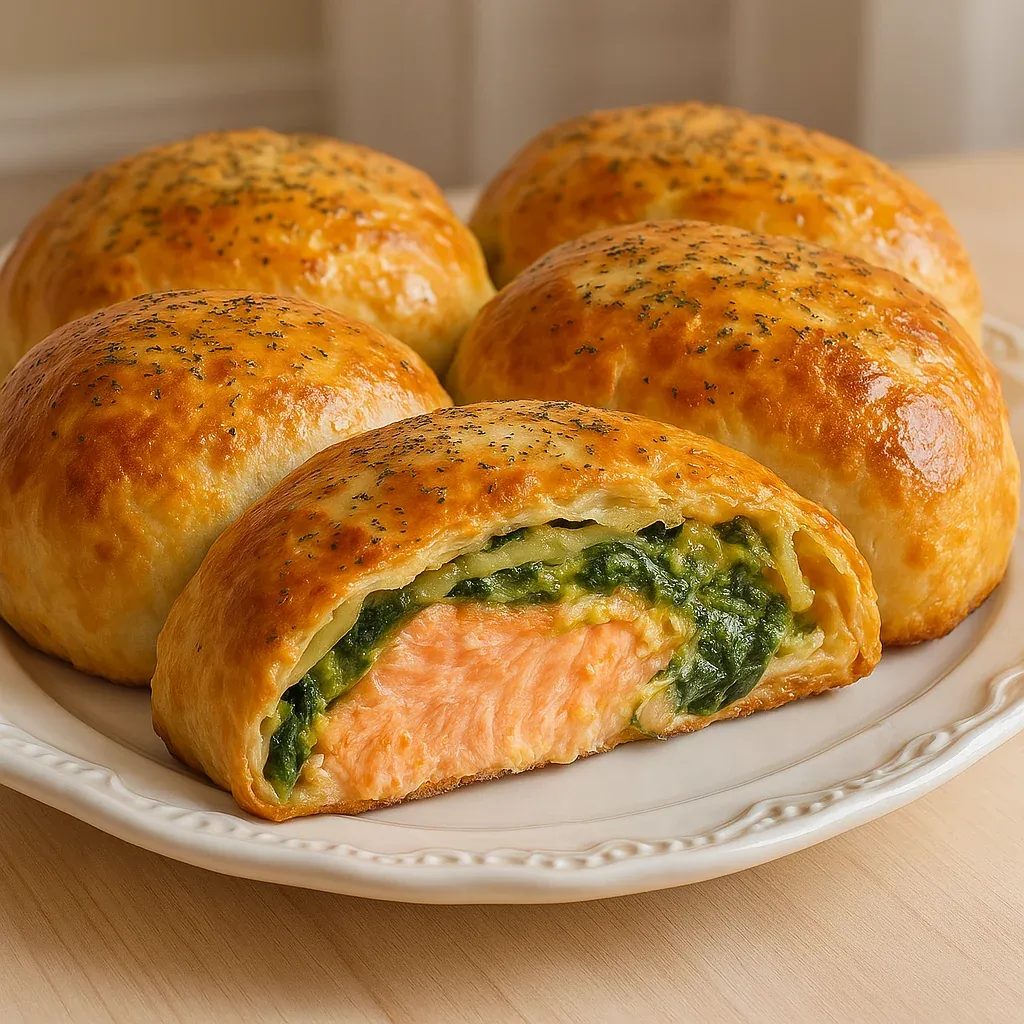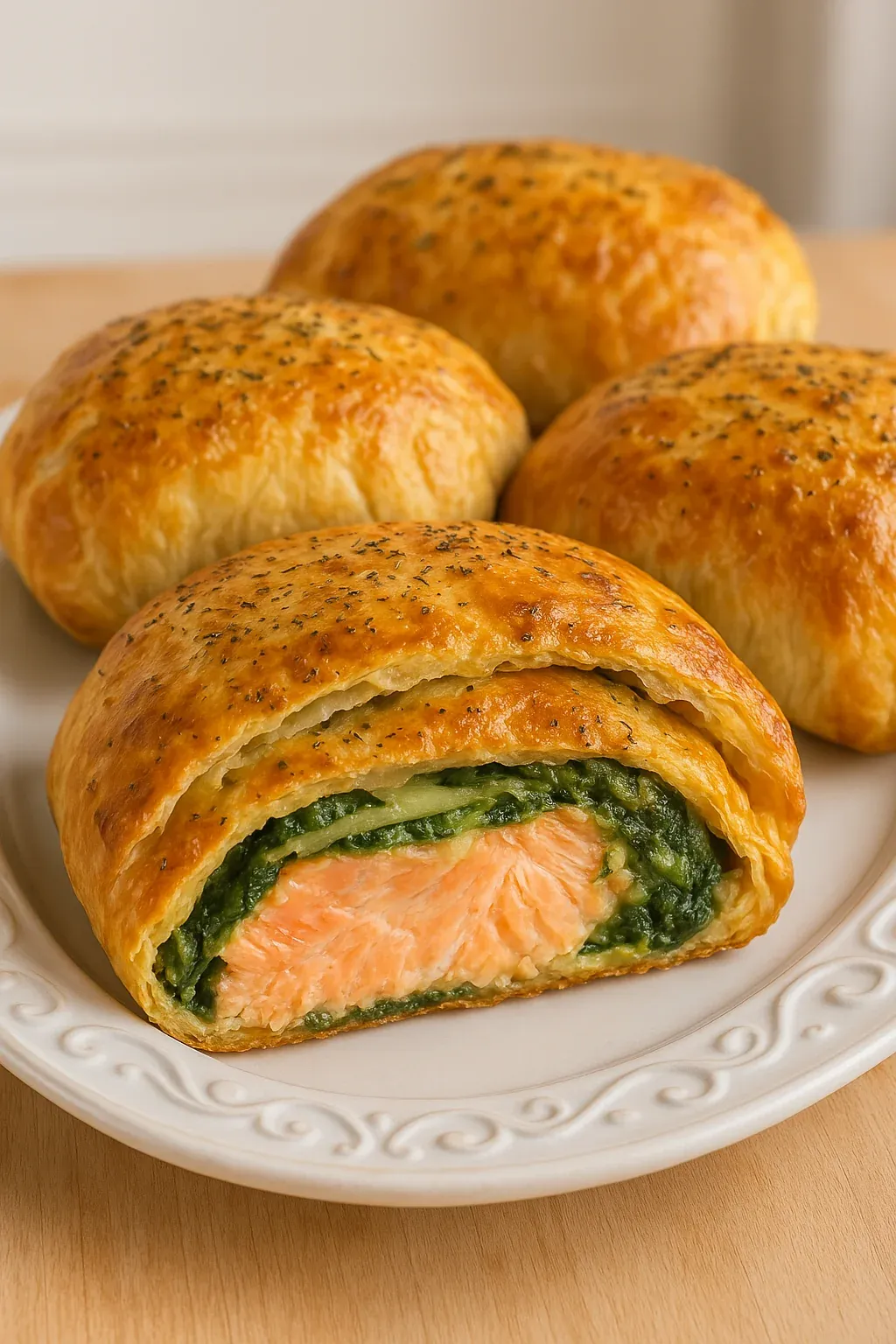 Pin it
Pin it
This showstopping Salmon Wellington turns everyday fish into a fancy dinner wrapped in flaky puff pastry. When you mix tender salmon, rich spinach filling, and golden-brown crust, you get a meal that looks super impressive but won't keep you slaving away in the kitchen.
I whipped up this Salmon Wellington during the 2020 lockdown when we couldn't go out for nice meals. What started as just a way to bring some excitement to dinner has now become our go-to dish when friends come over—everybody asks me how to make it before they head home.
What You'll Need
- Fresh salmon fillets: Get them without skin or bones. They should look bright and smell like the ocean
- Puff pastry: Let it thaw in your fridge overnight. The all-butter kind tastes way better
- Cream cheese: Make sure it's soft and at room temp so it mixes smoothly
- Fresh spinach: Wilt it and squeeze out water so your pastry doesn't get mushy
- Garlic: Chop it super fine for the best flavor
- Lemon zest: Adds a fresh kick that makes the salmon taste even better
- Dijon mustard: Gives a nice zip that cuts through the buttery crust
- Fresh dill: Goes with salmon like peanut butter goes with jelly
- Egg wash: This is what makes your pastry turn that beautiful golden color
How To Make It
- Mix Your Filling:
- Stir together the soft cream cheese with cooked spinach, tiny bits of garlic, lemon zest, and fresh dill until it's all mixed up. This creamy layer keeps the pastry from getting soggy and packs in tons of flavor. Make sure you've really squeezed all the water out of your spinach.
- Get Your Salmon Ready:
- Use paper towels to completely dry the salmon. Sprinkle salt and pepper all over it, then brush some Dijon mustard on top. It's a small step but it makes the flavor pop like crazy.
- Put It All Together:
- Roll your pastry on a floured counter until it's big enough to wrap around the salmon with about an inch extra all around. Spread your filling in the middle, put the salmon on top, then fold the pastry over. Use egg wash to stick the edges together. Trim off extra pastry but leave enough to make a good seal.
- Make It Pretty:
- Use leftover pastry bits to make little leaves or criss-cross patterns. Stick them on with egg wash, then brush the whole thing. Poke a few little holes in the top so steam can escape while it bakes.
- Cook It Up:
- Bake in a hot 425°F oven on a preheated oiled baking sheet for 20-25 minutes until it's golden and the inside hits 125°F for medium. Let it sit for 5 minutes before you cut into it with a sharp knife.
 Pin it
Pin it
The best moment is when you slice through that golden crust and see the beautiful pink salmon inside. I made this for my parents' anniversary once, and my dad said it beat any restaurant version he'd ever had—which is huge coming from someone who's super picky about seafood.
Keeping It Fresh
Your Salmon Wellington will stay good in the fridge for about 3 days if you keep it in a sealed container. When you want to warm it up, skip the microwave and use a 350°F oven for around 15 minutes to keep the crust crispy. You can also freeze these before cooking—just put them on a baking sheet until they're frozen solid, then wrap them up tight in plastic and foil. When you're ready to eat them, bake straight from the freezer and just add 10-12 extra minutes to the cooking time.
Great Side Dishes
This dish goes really well with light sides that don't steal the show. Try it with some roasted asparagus, a simple salad with lemon and arugula, or some small potatoes with herbs. For drinks, go with a bright Sauvignon Blanc or a Chardonnay without oak flavors—they cut through the richness and make the salmon taste even better.
 Pin it
Pin it
Fixing Common Problems
The biggest issue people run into is a soggy bottom crust. To avoid this, make sure your salmon is totally dry before you start and squeeze all the water out of your spinach. Another trick is to heat up your baking sheet first—the hot pan helps crisp up the bottom before it can get soggy. If the top is getting too brown but the inside needs more time, just lay some foil over it to stop it from burning.
Frequently Asked Questions
- → How should I bake this dish?
Turn your oven to 425°F and preheat a baking tray inside. Place the thawed dish onto the hot, greased tray, and bake until the crust turns golden and crisp. Use a thermometer to check if the salmon reaches 115°F for medium-rare. Let it sit before slicing.
- → Can I cook it without thawing?
Defrosting is better for even cooking, but you can cook it frozen. Expect longer baking times and keep an eye on the crust so it doesn’t burn.
- → What sauce pairs best with it?
A creamy Truffle Horseradish Sauce is an excellent match for this dish’s richness. Other great options include lemon butter or a light dill sauce to cut through the heaviness.
- → What’s the best way to store it?
The dish is vacuum-sealed for freezing, lasting up to a year frozen. Thawed items should be used within 3 days if kept in the fridge.
- → What sides go well with this?
Roasted veggies, buttery potatoes, or a crisp green salad make perfect companions for a balanced, delicious meal.
